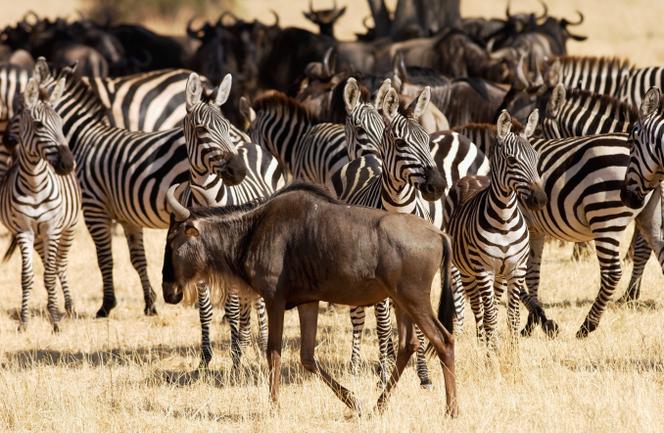


For animal lovers, the great Serengeti migration is a dream come true. Every year, some 2 million hoofed mammals cross the immense 24,000 km² national park in northern Tanzania. In April, zebra, wildebeest and Thomson's gazelle leave the open, fertile savannah in the south and slowly make their way north to the more forested area. They remain there from July to September, then move south again at the same pace, reaching the south in December. This movement is even more massive in that it involves not one, but three species. A phenomenon unique in the world, this great pendulum movement has determined the very boundaries of the park. It also contributes to the park's resources, as hundreds of thousands of visitors come to watch the show.
For the past 50 years, zoologists and ecologists have been fascinated by another curiosity: the order of appearance of the three main players. Zebra first, followed closely by wildebeest and, finally, gazelle. Always in that order. At 230 kg, the zebra is heavier than the wildebeest (180 kg) and would crush the frail gazelle (20 kg). But that argument doesn't seem to carry much weight.
On the other hand, three theories have been in constant conflict since the first landmark study on the subject, conducted by Richard Bell in 1971. One theory sees this as the result of competition for resources. Another, on the contrary, favors what Bell called "facilitation," with each species preparing the ground for the next. Finally, a third theory sees predation, or rather the fight against large predators, as the main force, with each species acting as both shield and sentinel for the others. "Strangely enough, we've been lacking a comprehensive study at different scales to try and settle the matter," said T. Michael Anderson, an American professor of biology at Wake Forest University in North Carolina. The research he has just coordinated and published in the journal Science has finally provided the answer.
To achieve this, an international team gathered eight years' worth of diverse data. First, images from camera traps set up in a transition zone in the middle of the park. Next, GPS collars fitted to individuals of all three species were tracked. And finally, a detailed analysis of the DNA found in the animals' excrement, in order to understand their diet. They subjected this voluminous corpus to environmental data, fire and precipitation.
The first finding was that there was no evidence to support a predation effect. "Otherwise, we'd expect to see more associations between species in more forested areas, where there are more predators, but that's not the case," said Johan Pansu, senior lecturer in ecology at the University of Lyon, who took part in the study during his postdoc at Princeton University. On the other hand, the detailed study showed that the other two forces acted simultaneously. If the 200,000 or so zebra took care to stay to the front, or rather to the side of the migration front, it was to keep away from the 1.3 million wildebeest. Moreover, in years of heavy rainfall, when resources were abundant, they didn't mind being closer. The wildebeest, on the other hand, followed as they took advantage of the first blades crossed by the zebras to gain access to lower, richer grass.
You have 15% of this article left to read. The rest is for subscribers only.
